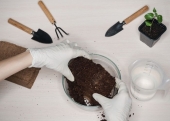
 1
1








-





 1
1




Islands or floating gardens on the Dal lake in Kashmir, are formed from the weeds, after collecting them from the lake itself. Such weeds mostly consist of Typha augustata and Phragmites communis which are in Kashmiri language known as Pech and Nargasa, respectively. Some other hydrophytes like Trapa spp (Gair, Singhara in Urdu) and the almost extinct Eurale ferox, are also occasionally used to form floating gardens.
The boatmen after collecting the weeds, press the roots of one against those of the next, then of next against those of the two and so on.The weeds with their muddy and sticky roots get so coalesced that these can hardly be separated. The boatmen then prune the tall culms and, thus, they themselves make mats. These mats float in the lake water which eventually constitute floating gardens. The boatmen may double the thickness of their floating gardens by stowing over them a second layer of weeds after pruning away their culms in the same year. They may similarly have a third layer over the second onwards, because the garden tends to lose its thickness by the constant play of water underneath, repeat such layering after two or three years.
The boatmen, thus, maintain floating gardens at a thickness of 1 to 2m with width about 2.5 to 3.0 m and in length around 45m or sometimes 90 to 135m. They have their ingenious technique for uniting small pieces together. They moor two pieces end to end. Along the seam they plant willow cuttings in such a way that two ends of each go deep into the two adjacent margins much like the cramps of boat. Almost every such cutting puts forth elaborate adventitious root system, traverse both to the margins together, strongly seam the other gardens.
Classification of Floating Gardens
Floating gardens are of two kinds which are locally called Radh and Demb types. The Radh type of floating gardens are made of long strips of lake reeds having a breadth of about 2m and can be pulled from one place to another. Not ineferior to the Radh in productivity are Demb lands which are formed along the sides or sometimes in the middle of the lake when the water is shallow (Gupta et al.1983).
![Filename: floating-garden-in-kashmir-from-asiagracedotcom.jpg
Description: [Thumbnail for floating-garden-in-kashmir-from-asiagracedotcom.jpg]](/t/69112/a/53296/floating-garden-in-kashmir-from-asiagracedotcom.jpg)
![Filename: floating-gardens-of-dal-lake-1881.jpg
Description: [Thumbnail for floating-gardens-of-dal-lake-1881.jpg]](/t/69112/a/53297/floating-gardens-of-dal-lake-1881.jpg)
Works at a residential alternative high school in the Himalayas SECMOL.org . "Back home" is Cape Cod, E Coast USA.








NON ASSUMPSIT. I am by no means an expert at anything. Just a lucky guesser.

|
This tiny ad cleans with warm water instead of toxic gick and gained 20 IQ points!
Learn Permaculture through a little hard work
https://wheaton-labs.com/bootcamp
|


